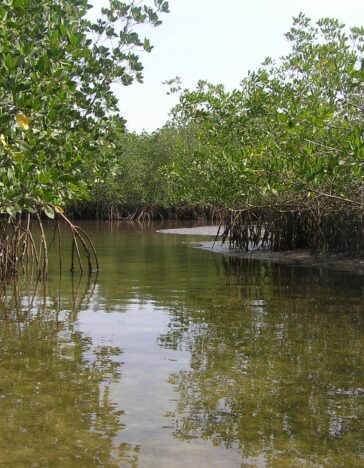
Countries can strengthen climate plans in 2020 with peatland and mangrove targets
-
Climate mitigation and adaptation
-
Coastal resilience
-
Coastal wetland conservation
-
Peatland conservation and restoration
There is untapped mitigation potential and a significant opportunity to include and expand peatlands and mangroves in the future, revised national climate plans of all countries with carbon-rich wetlands. Both peatlands and mangroves are emphasised in the Synthesis report of the Talanoa Dialogue which indicates key priorities to adhere to the goals of the Paris Agreement. The report provides a comprehensive starting point for the political phase during the 24th UNFCCC climate summit in Poland which kicks off next week.
Current national climate plans (Nationally Determined Contributions (NDCs)) under the Paris Agreement do not recognise or quantify the contribution of safeguarding and restoring peatlands to keep carbon in the ground and reduce greenhouse gas emissions. While 118 countries have mangrove forests within their national boundaries, only 28 countries included coastal wetlands as a mitigation component, from changing policies to replanting entire mangrove forests.
Starting in 2020, when the Paris Agreement starts the implementation phase and every five years onward, nations will be requested to resubmit their NDCs – with revised and more ambitious actions and targets. The opportunity is therefore ripe to strengthen NDCs by considering peatlands and mangroves as a low-hanging fruit for achieving mitigation and adaptation ambitions and provide more information on detailed targets in 2020.
The Talanoa Dialogue Synthesis of the Preparatory Phase which outlines key steps that can be taken by Parties and stakeholders over the coming years to adhere to the goals of the Paris Agreement, highlights that by 2030 the world should have increased protection to natural carbon sinks and reservoirs – such as forests, peatlands and mangroves in a way that respects all Sustainable Development Goals. Wetlands International has contributed to the Talanoa Dialogue through submissions which outline the climate change mitigation and adaptation potential of peatlands and mangroves and wetlands overall and provide recommendations on how to get there.
Some highlights:
Peatlands only cover about 3% of the world’s land surface, but store at least twice as much carbon as all of Earth’s standing forests. Mangrove soils hold over 6.4 billion tons of carbon, 4.5 times more carbon than the US economy emits every year and can sequester up to 3-4 times more carbon on an area basis than their terrestrial counterparts.
Some 15% of the world’s peatlands have been drained for agriculture, forestry and grazing, which leads to oxidation and the release of the carbon stored in their soils. Degrading peatlands contribute at least 5% to the total global anthropogenic emissions, which is almost double the amount of CO2 emissions from aviation, even without skyrocketing emissions from peat fires. These emissions can be reduced by rewetting drained peatlands and implementing alternative forms of use, such as paludiculture (wet peatland use). Mangrove conversion accounts for average emissions of 7.2 Mg CO2 ha-1 yr-1.
Enhancing ambition can also include strengthening the adaptation section of an NDC utilising ecosystem-based adaptation in policies and plans. Mangroves provide a natural barrier for coastal communities and whole ecosystems from storm surge, flooding and erosion. Peatlands purify water, store water thereby mitigating flooding and droughts, and preserve permafrost. Both wetlands types provide a home for rare species.
The recently launched Mangrove Restoration Potential map (MRP) by the Nature Conservancy and IUCN, informed by global mangrove extent maps coordinated by Wetlands International (through the Mangrove Watch programme), shows that from the more than 8000,000 ha of lost coastal mangroves globally, 500,000 ha are highly restorable. Another 200,000 ha have been identified as degraded mangroves, yet with proper management actions being in a position to be fully recovered.
The Global Peatland Hotspots Map published in 2015 shows that 25 countries are together responsible for 95% of global emissions from peatland drainage, excluding fires (primarily Indonesia and Russia) and that emissions from peatlands are often of national significance. In these countries peatlands should be given priority for conservation, restoration and wise use in the NDCs and in national policies and strategies of countries with peatlands.
To create an enabling policy environment for wetland conservation, restoration and wise use, the development of a Strategic Plan has proven to be effective. For example, in Mongolia, Wetlands International and its partners implemented a rapid assessment study, which enabled a nationwide dialogue with stakeholders to facilitate the national priority actions for sustainable peatlands management. The strategic planning has been supported by a pilot project on peatlands management and restoration, which demonstrated a possible peatland management approach developed together with local herders. Mongolia will include peatland actions in its next NDC to accelerate action. This strategic planning approach could be expanded to countries with similar problems.
For both peatlands and mangroves, coordinated global initiatives have started to accelerate existing work, while also funnelling significant new global investment into such projects:
- The Global Mangrove Alliance, serves as a platform to drive action, linking separate projects into a cohesive path to increasing mangrove cover by 20% by 2030 and in doing so, reduce greenhouse gas emissions while making communities more resilient. It was initiated in 2017, five of the world’s leading global conservation organizations – Conservation International, the International Union for Conservation of Nature, The Nature Conservancy, Wetlands International, and World Wildlife Fund. The GMA provides one way to take action on mangrove conservation and restoration towards climate mitigation and adaptation.
- The Global Peatland Initiative, brings together UN agencies, governments, and NGOs to support countries in the conservation, better management and restoration of peatlands, and to facilitate South-South cooperation. In this way, the Initiative contributes to reducing greenhouse gas emissions, maintaining ecosystem services and securing lives and livelihoods through improved adaptive capacity. Wetlands International is a member of the Global Peatlands Initiative.



